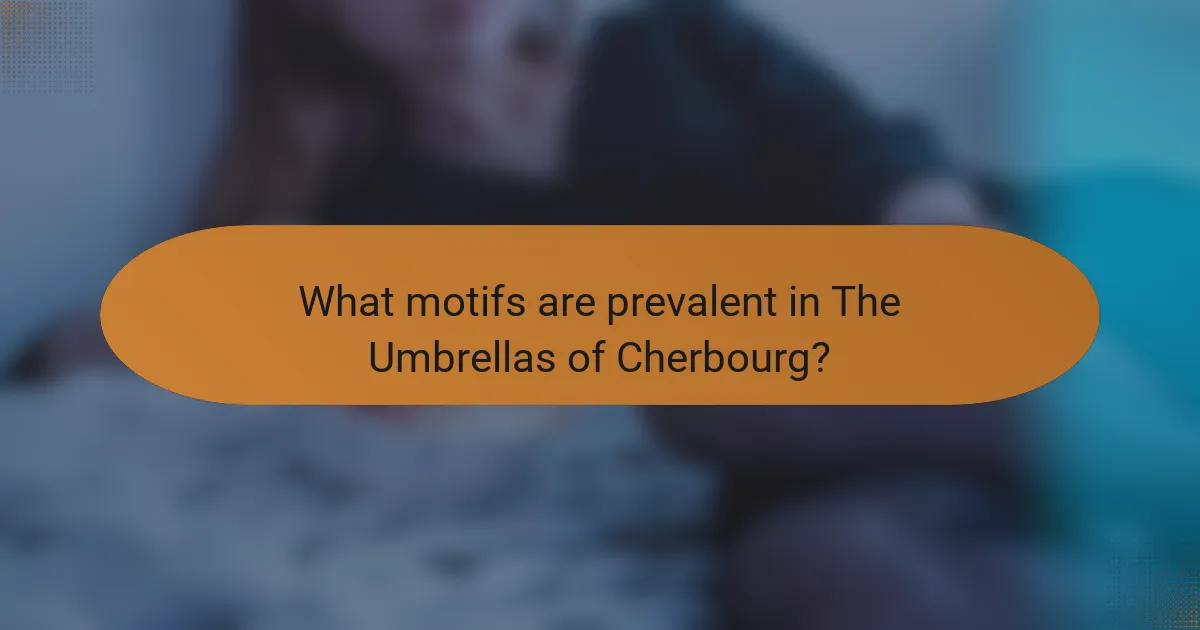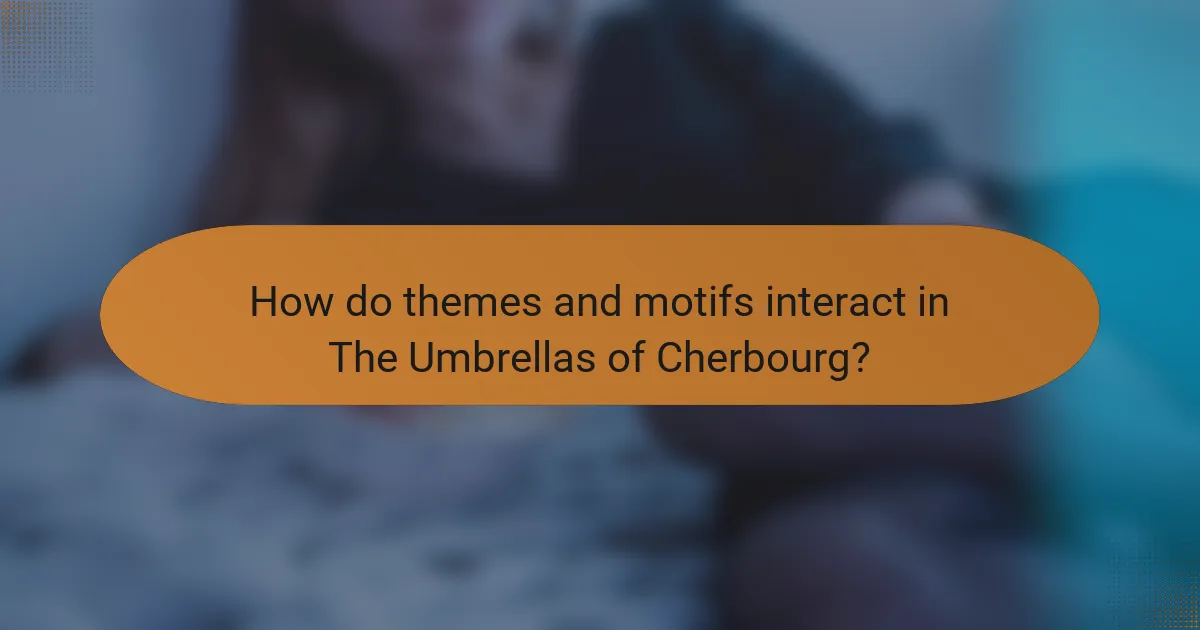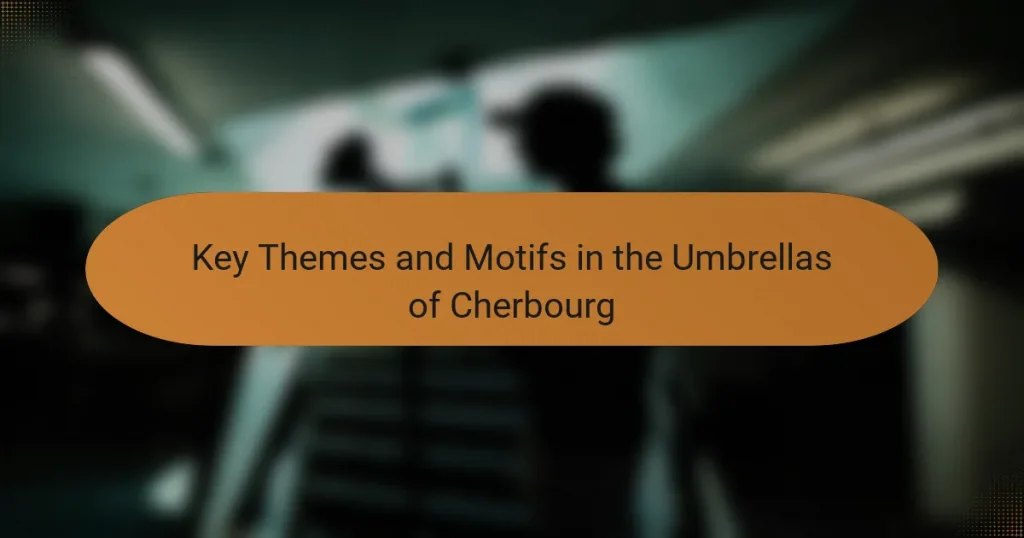The Umbrellas of Cherbourg is a film that explores key themes such as love, loss, and the passage of time. The intense relationship between the characters Geneviève and Guy exemplifies love’s fleeting nature, while their separation due to Guy’s military draft highlights the pain of unfulfilled dreams. The narrative is enriched by motifs like vibrant colors symbolizing emotions and music reflecting longing and nostalgia. Additionally, the changing seasons illustrate the impact of time on relationships, creating a cohesive emotional experience that underscores the complexities of human emotions and connections.

What are the key themes in The Umbrellas of Cherbourg?
The key themes in The Umbrellas of Cherbourg include love, loss, and the passage of time. Love is portrayed as intense yet fleeting, exemplified by the relationship between Geneviève and Guy. Loss is evident as circumstances separate the lovers, highlighting the pain of unfulfilled dreams. The passage of time is depicted through the changing seasons and the characters’ evolving lives. These themes intertwine to create a poignant narrative about the complexities of human emotions and relationships.
How do love and sacrifice manifest in the film?
Love and sacrifice manifest in “The Umbrellas of Cherbourg” through the characters’ emotional struggles and choices. The protagonist, Geneviève, faces a dilemma between her love for Guy and her obligation to her mother. She sacrifices her happiness by marrying Roland, a wealthy man, to ensure financial stability. Guy, in turn, sacrifices his dreams and desires to serve in the military. Their love is portrayed as deep and genuine, yet constrained by external circumstances. The film’s poignant music underscores these themes, enhancing the emotional weight of their sacrifices. Ultimately, the narrative illustrates how love can lead to difficult choices that require personal sacrifice.
What specific scenes illustrate the theme of love?
The theme of love in “The Umbrellas of Cherbourg” is illustrated through several key scenes. One significant scene is when Geneviève and Guy share a passionate kiss before he leaves for war. This moment captures their intense romantic connection. Another important scene occurs when Geneviève learns of Guy’s return and her emotional turmoil is evident. Her conflicted feelings highlight the complexities of love. Additionally, the scene where Geneviève and her mother discuss her future choices emphasizes the sacrifices made for love. These scenes collectively demonstrate the depth and challenges of love in the narrative.
In what ways do characters demonstrate sacrifice?
Characters demonstrate sacrifice through selfless actions for the benefit of others. In “The Umbrellas of Cherbourg,” Geneviève sacrifices her love for Guy to ensure his happiness and safety. She chooses to marry Roland, a wealthier man, to provide a stable future for her unborn child. Guy, on the other hand, sacrifices his dreams and desires to serve in the military. His commitment to duty leads him away from Geneviève, showcasing the emotional toll of sacrifice. These actions illustrate the theme of love intertwined with personal sacrifice throughout the film.
What role does time play in the narrative?
Time serves as a crucial element in the narrative of “The Umbrellas of Cherbourg.” It shapes the characters’ relationships and decisions. The story unfolds over a span of years, highlighting the impact of time on love and longing. Time also emphasizes the inevitability of change and the passage of life. The use of musical numbers further accentuates the emotional weight of temporal transitions. For instance, the characters experience moments of joy and sorrow that are deeply tied to specific timeframes. This connection illustrates how time influences their choices and emotional states. Overall, time acts as both a narrative device and a thematic underpinning, reinforcing the film’s exploration of love and loss.
How does the passage of time affect character relationships?
The passage of time significantly alters character relationships in “The Umbrellas of Cherbourg.” As time progresses, characters experience growth and change. Their emotional connections evolve due to personal circumstances and external influences. For example, Geneviève’s relationship with Guy shifts as she navigates motherhood and societal pressures. Guy’s experiences in the military also impact his feelings and priorities. The film illustrates how time can create distance or foster new understandings. Ultimately, the characters’ journeys reflect the complexities of love and commitment over time.
What symbols are used to represent time in the film?
The symbols used to represent time in “The Umbrellas of Cherbourg” include clocks and seasonal changes. Clocks appear throughout the film, emphasizing the passage of time in the characters’ lives. The changing seasons symbolize the emotional transitions and the inevitable progression of life. For example, the vibrant colors of spring contrast with the somber tones of winter. This visual representation reinforces the themes of longing and nostalgia. The film’s narrative structure also reflects time’s impact, as it spans several years. Overall, these symbols effectively illustrate the relationship between time and the characters’ experiences.

What motifs are prevalent in The Umbrellas of Cherbourg?
The prevalent motifs in The Umbrellas of Cherbourg include love, separation, and the passage of time. Love is depicted through the intense relationship between Geneviève and Guy. Their romance is characterized by youthful passion and idealism. Separation occurs when Guy is drafted into the military, leading to emotional turmoil. The motif of time is illustrated through the changing seasons and the impact of time on relationships. The film employs vibrant colors to symbolize emotions and experiences. Each motif interconnects to depict the bittersweet nature of love and loss.
How is color used as a motif throughout the film?
Color serves as a significant motif throughout “The Umbrellas of Cherbourg.” It enhances emotional depth and conveys character experiences. The film employs a vibrant color palette to reflect the characters’ moods and situations. For instance, bright yellow symbolizes hope and happiness, particularly in scenes depicting love and optimism. Conversely, darker shades like blue often represent sadness and loss, especially in moments of separation. The use of color also aligns with the musical score, creating a cohesive emotional narrative. Each color choice is intentional, reinforcing the film’s themes of love, longing, and heartbreak. Overall, color is integral to storytelling in “The Umbrellas of Cherbourg.”
What emotions do different colors evoke in key scenes?
Different colors evoke specific emotions in key scenes of “The Umbrellas of Cherbourg.” For example, red often symbolizes love and passion. In scenes where red is prominent, characters experience intense feelings of desire. Blue typically conveys sadness and melancholy. Key scenes featuring blue highlight the characters’ emotional struggles and longing. Yellow is associated with happiness and optimism. When yellow appears, it reflects moments of joy and hope. Green represents renewal and growth, often seen in scenes of transformation. Each color choice is intentional, enhancing the emotional depth of the narrative. The film’s use of color aligns with psychological studies showing that colors can influence emotions and perceptions.
How does color contribute to the overall aesthetic?
Color significantly contributes to the overall aesthetic by influencing emotions and perceptions. In “The Umbrellas of Cherbourg,” vibrant colors create a dreamlike atmosphere. The use of primary colors enhances the film’s emotional depth. For example, yellow symbolizes hope, while blue conveys sadness. Each color choice is intentional, guiding viewers’ feelings throughout the narrative. Research shows that color can evoke specific emotional responses, affecting audience engagement. This strategic use of color reinforces the film’s themes of love and loss. The overall aesthetic is thus intricately tied to the color palette, shaping the viewer’s experience.
What musical elements serve as motifs in the film?
The musical elements that serve as motifs in the film “The Umbrellas of Cherbourg” include recurring melodies and specific instrumental arrangements. The main theme, characterized by its poignant and romantic melody, appears throughout the film, enhancing emotional depth. Additionally, the use of orchestral strings and woodwinds creates a lush soundscape that supports the narrative. The film’s score, composed by Michel Legrand, integrates these motifs seamlessly into the dialogue, emphasizing key moments. The motifs also reflect the characters’ emotional states, reinforcing the film’s themes of love and loss. Each musical element is carefully crafted to evoke specific feelings, making the score integral to the storytelling. The consistent use of these motifs helps to unify the film’s narrative structure and emotional impact.
How does the score enhance the storytelling?
The score enhances the storytelling by conveying emotions and setting the tone throughout the narrative. Music in “The Umbrellas of Cherbourg” underscores dramatic moments and complements character development. For instance, the recurring themes reflect the protagonist’s emotional journey. The score integrates seamlessly with the visual elements, creating a cohesive experience. Research indicates that music influences audience perception and emotional engagement. A study by Juslin and Västfjäll (2008) found that music significantly affects emotional responses in film. Thus, the score serves as a vital narrative device that deepens the audience’s connection to the story.
What recurring musical themes are significant to the plot?
The recurring musical themes significant to the plot of “The Umbrellas of Cherbourg” include love, longing, and loss. These themes are expressed through the film’s operatic score. The music underscores the emotional journey of the characters. For instance, the love theme accompanies the initial romance between Guy and Geneviève. As the story progresses, variations of this theme reflect their separation and yearning. The use of recurring motifs enhances the narrative’s emotional depth. Each musical piece aligns with key plot points, reinforcing the characters’ feelings and experiences. The score, composed by Michel Legrand, is integral to the film’s storytelling.

How do themes and motifs interact in The Umbrellas of Cherbourg?
Themes and motifs in The Umbrellas of Cherbourg interact by reinforcing the emotional landscape of the narrative. The primary theme of love is depicted through the motif of color, particularly the vibrant umbrellas. These umbrellas symbolize the characters’ emotions and the transient nature of their relationships. The use of music as a motif underscores the theme of longing and nostalgia. Each song reflects the characters’ internal struggles and desires. Additionally, the motif of time plays a crucial role in illustrating the theme of separation. The passage of time affects the characters’ choices and their eventual outcomes. Together, these elements create a cohesive emotional experience, highlighting the bittersweet nature of love and loss.
What is the relationship between love and the use of color?
The relationship between love and the use of color is significant in “The Umbrellas of Cherbourg.” Color conveys emotions and enhances storytelling. In the film, vibrant colors symbolize the intensity of love. For example, warm colors like red and pink often represent passion and romance. Conversely, cooler colors may indicate sadness or loss. The use of color helps visualize the characters’ emotional states. This technique is evident in scenes where color shifts reflect changing relationships. Research on color psychology supports these associations, showing that colors can evoke specific feelings. The film’s color palette thus deepens the audience’s understanding of love’s complexities.
How do color choices reflect the emotional states of characters?
Color choices in “The Umbrellas of Cherbourg” vividly reflect the emotional states of characters. Bright colors often signify joy or love, while darker hues indicate sadness or despair. For example, the use of vibrant yellow signifies the optimism and happiness of Geneviève at the beginning. Conversely, when the colors shift to greys and blues, it mirrors her emotional turmoil later in the story. This intentional use of color aligns with psychological theories, such as color psychology, which suggest colors can evoke specific feelings. The film’s cinematography reinforces these emotional transitions, illustrating how color serves as a visual language for character emotions.
In what ways do musical motifs underscore the themes of sacrifice?
Musical motifs in “The Umbrellas of Cherbourg” emphasize the themes of sacrifice through their emotional resonance and repetitive nature. These motifs often accompany pivotal moments, highlighting characters’ struggles and decisions. For instance, the recurring melody associated with Geneviève underscores her internal conflict between love and duty. This motif evolves, reflecting her sacrifices as she navigates her relationship with Guy and her obligations. The orchestration often swells during moments of emotional turmoil, reinforcing the weight of sacrifice. Additionally, contrasting motifs represent different choices, illustrating the tension between personal desire and societal expectations. This interplay of motifs effectively deepens the narrative’s exploration of sacrifice.
How does the music highlight moments of emotional sacrifice?
The music in “The Umbrellas of Cherbourg” highlights moments of emotional sacrifice through its poignant melodies and lyrical content. Each musical piece reflects the characters’ inner turmoil and longing. For instance, the use of minor keys evokes feelings of sadness and loss. The orchestration often crescendos during pivotal scenes, amplifying emotional weight. Specific songs underscore sacrifices made for love, such as the decision to part ways for a better future. This interplay between music and narrative deepens the audience’s emotional connection. The score, composed by Michel Legrand, is integral to conveying these themes. It enhances the storytelling by mirroring the characters’ emotional journeys, making their sacrifices resonate profoundly.
What insights can be gained from analyzing themes and motifs together?
Analyzing themes and motifs together reveals deeper narrative connections and emotional resonance. Themes represent the underlying messages or central ideas in a work, while motifs are recurring elements that reinforce these themes. For example, in “The Umbrellas of Cherbourg,” the theme of love’s impermanence is accentuated by the motif of umbrellas, symbolizing protection and vulnerability. This interplay highlights how characters navigate their relationships amidst changing circumstances. By examining both aspects, one can uncover how visual and narrative elements interact to enhance the overall meaning. This approach allows for a richer understanding of the artistic choices made by the creators.
The main entity of the article is “The Umbrellas of Cherbourg,” a film that explores key themes and motifs such as love, loss, and the passage of time. The article provides an analysis of how love and sacrifice manifest through the characters’ emotional struggles, the impact of time on relationships, and the use of color and music as motifs that enhance the narrative. Specific scenes are examined to illustrate these themes, highlighting the complexities of human emotions and the interplay between visual and auditory elements. Overall, the article delves into the intricate connections between themes and motifs, offering insights into the film’s exploration of love’s impermanence and the emotional weight of sacrifice.


